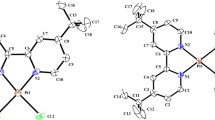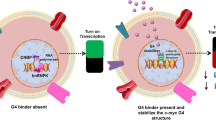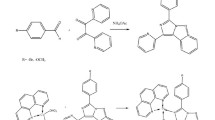Abstract
The c-MYC gene plays an important role in the regulation of cell proliferation and growth and it is overexpressed in a wide variety of human cancers. Around 90% of c-MYC transcription is controlled by the nuclease-hypersensitive element III1 (NHE III1), whose 27-nt purine-rich strand has the ability to form a G-quadruplex structure under physiological conditions. Therefore, c-MYC DNA is an attractive target for drug design, especially for cancer chemotherapy. Here, the interaction of water-soluble tetrapyridinoporphyrazinatozinc(II) with 27-nt G-rich strand (G/c-MYC), its equimolar mixture with the complementary sequence (GC/c-MYC) and related C-rich oligonucleotide (C/c-MYC) is investigated. Circular dichroism (CD) measurements of the G-rich 27-mer oligonucleotide in 150 mM KCl, pH 7 demonstrate a spectral signature consistent with parallel G-quadruplex DNA. Furthermore, the CD spectrum of the GC rich oligonucleotide shows characteristics of both duplex and quadruplex structures. Absorption spectroscopy implies that the complex binding of G/c-MYC and GC/c-MYC is a two-step process; in the first step, a very small red shift and hypochromicity and in the second step, a large red shift and hyperchromicity are observed in the Q band. Emission spectra of zinc porphyrazine are quenched upon addition of three types of DNA. According to the results of spectroscopy, it can be concluded the dominant binding mode is probably, outside binding and end stacking.






Similar content being viewed by others
References
Meyer, N., Penn, L.Z.: Reflecting on 25years with MYC. Nat. Rev. Cancer 8, 976–790 (2008)
Pelengaris, S., Rudolph, B., Littlewood, T.: Action of Myc in vivo-proliferation and apoptosis. Curr. Opin. Genet. Dev. 10, 100–105 (2000)
Facchini, L.M., Penn, L.Z.: The molecular role of Myc in growth and transformation: recent discoveries to new insights. FASEB J. 12, 633–651 (1998)
Nema, R.: c-Myc (Oncogenic) transcription factor. Ind. J. Fund. Appl. Life Sci. 1, 2231–6345 (2011)
Lutz, W., Leon, J., Eilers, M.: Eilers, Contributions of Myc to tumorigenesis. Biochim. Biophys. Acta 1602, 61–71 (2002)
Marcu, K.B., Bossone, S.A., Patel, A.J.: Myc function and regulation. Annu. Rev. Biochem. 61, 809–860 (1992)
Simonsson, T., Pecinka, P., Kubista, M.: DNA tetraplex formation in the control region of c-Myc. Nucleic Acids Res. 26, 1167–1172 (1998)
Sun, D., Hurley, L.H.: The importance of negative superhelicity in inducing the formation of G-quadruplex and i-motif structures in the c-Myc promoter: implications for drug targeting and control of gene expression. J. Med. Chem. 52, 2863–2874 (2009)
Brooks, T.A., Hurley, L.H.: Targeting MYC expression through G-quadruplexes. Genes Cancer 1, 641–649 (2010)
Yoon, J., Kang, H., Sung, J., Park, H. J., Hohng, S.: Highly polymorphic G-quadruplexes in the c-MYCPromoter. Bull. Korean Chem. Soc. 31, 1025–1028 (2010)
Siddiqui-Jain, A, Grand, C.L, Bearss, D.J, Hurley, L.H.: Direct evidence for a G-quadruplex in a promoter region and its targeting with a small molecule to repress c-MYC transcription. Proc. Natl. Acad. Sci. U.S.A. 99, 11593–1158 (2002)
Yang, D, Okamoto, K.: Structural insights into G-quadruplexes: towards new anticancer drugs. Future Med. Chem. 2, 619–646 (2010)
Freyer, M.W., Buscaglia, R., Kaplan, K., Cashman, D., Hurley, L.H., Lewis, E.A.: Biophysical studies of the c-MYC NHE III1 promoter: model quadruplex interactions with a cationic porphyrin. Biophys. J 92, 2007–2015 (2007)
Seenisamy, J., Bashyam, S., Gokhale, V., Vankayalapati, H., Sun, D., Siddiqui-Jain, A., Streiner, N., Shin-ya, K., White, E., Wilson, W.D., Hurley, L.H.: Design and synthesis of an expanded porphyrin that has selectivity for the c-MYC G-quadruplex structure. J. Am. Chem. Soc. 127, 2944–2959 (2005)
Safaei, E., Ranjbar, B., Hasani, L.: A study on the self assembly of Fe(II) and dual binding of Ni(II) porphyrazines on CT-DNA. J. Porphyrins Phthalocyanines 11, 805–814 (2007)
Asadi, M., Safaei, E., Ranjbar, B., Hasani, L.: Thermodynamic and spectroscopic study on the binding of cationic Zn(II) and Co(II) tetrapyridinoporphyrazines to calf thymus DNA: the role of the central metal in binding parameters. New J. Chem. 28, 1227–1234 (2004)
Kelly, S M., Jess, T. J., Price, N.C.: How to study proteins by circular dichroism. Biochem. Biophys. Acta 1751, 119–139 (2005)
Kypr, J., Kejnovska, I., Renciuk, D., Vorlickova, M.: Circular dichroism and conformational polymorphism of DNA. Nucleic Acids Res. 37, 1713–1725 (2009)
Paramasivan, S., Rujan, I., Bolton, P.H.: Circular dichroism of quadruplex DNAs: applications to structure, cation effects and ligand binding. Methods 43, 324–331 (2007)
Vorlickova, M., Kejnovska, I., Sagi, J., Renciuk, D., Bednarova, K., Motlova, J., Kypr, J.: Circular dichroism and guanine quadruplexes. Methods 57, 64–75 (2012)
Anantha, N.V., Azam, M., Sheardy, R.D.: Porphyrin binding to quadruplexed T4G4. Biochemistry 37, 2709–2714 (1998)
Yamashita, T., Uno, T., Ishikawa, Y.: Guanine quadruplex DNA by the binding of porphyrins with cationic side arms. Bioorg. Med. Chem. 13, 2423–2430 (2005)
Ghazaryan, A.A., Dalyan, Y.B., Haroutiunian, S.G., Tikhomirova, A., Taulier, N., Wells, J.W., Chalikian, T.V.: Thermodynamics of interactions of water-soluble porphyrins with RNA duplexes. J. Am. Chem. Soc. 128, 1914–1921 (2006)
Suh, D., Chaires, J.B.: Criteria for the mode of binding of DNA binding agents. Bioorg. Med. Chem. 3, 723–728 (1995)
Nagesh, N., Sharma, V.K., Kumar, A.G., Lewis, E.A.: Effect of ionic strength on porphyrin drugs interaction with quadruplex DNA formed by the promoter region of C-myc and Bcl2 oncogenes. J. Nucleic Acids 2010, 1–9 (2010)
Zhao, P., Xu, L., Huang, J., Fu, B., Yu, H., Ji, L.: Cationic porphyrin–anthraquinone dyads: modes of interaction with G-quadruplex DNA. Dyes Pigments 82, 81–87 (2009)
Acknowledgments
Financial support for this work was provided by the Research Council of Institute for Advanced Studies in Basic Sciences.
Author information
Authors and Affiliations
Corresponding author
Rights and permissions
About this article
Cite this article
Hassani, L., Fazeli, Z., Safaei, E. et al. A spectroscopic investigation of the interaction between c-MYC DNA and tetrapyridinoporphyrazinatozinc(II). J Biol Phys 40, 275–283 (2014). https://doi.org/10.1007/s10867-014-9348-x
Received:
Accepted:
Published:
Issue Date:
DOI: https://doi.org/10.1007/s10867-014-9348-x




